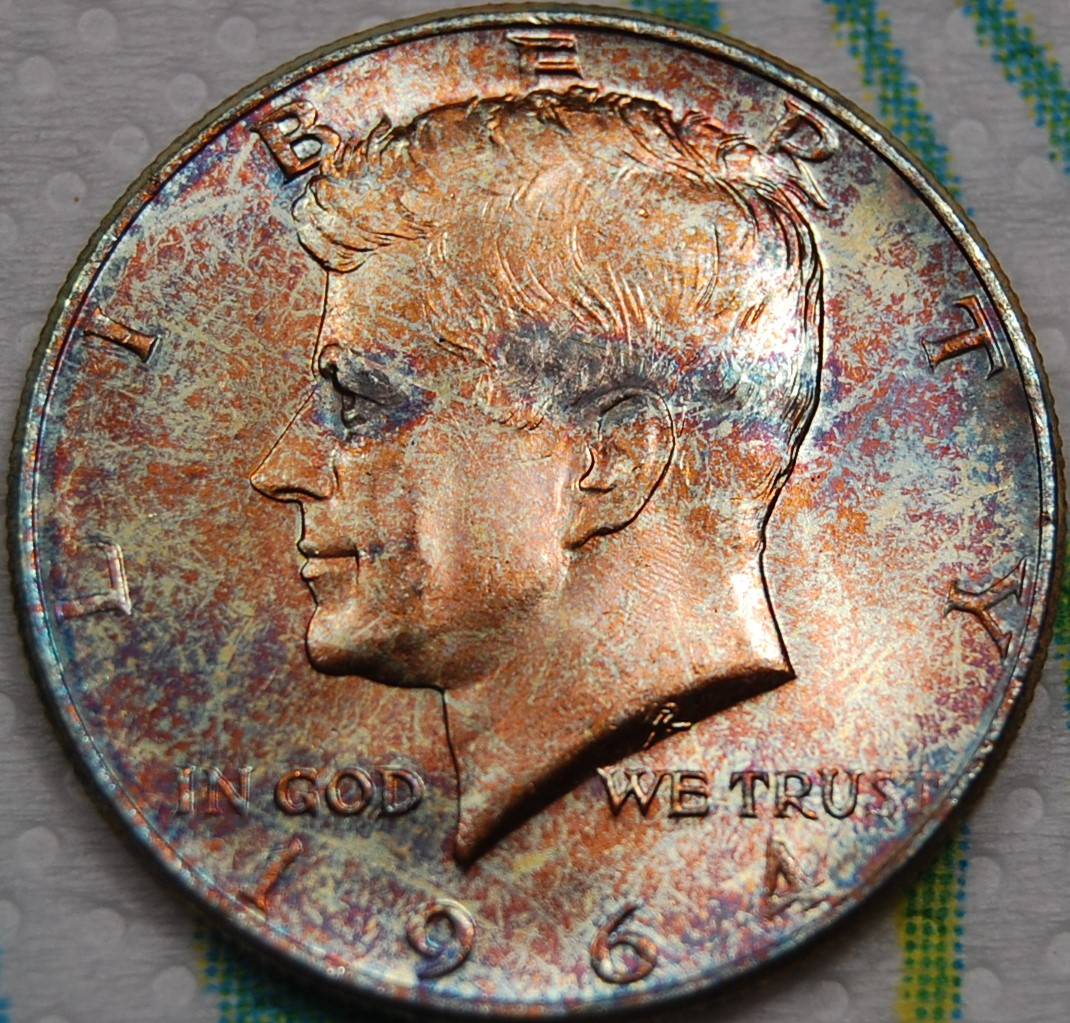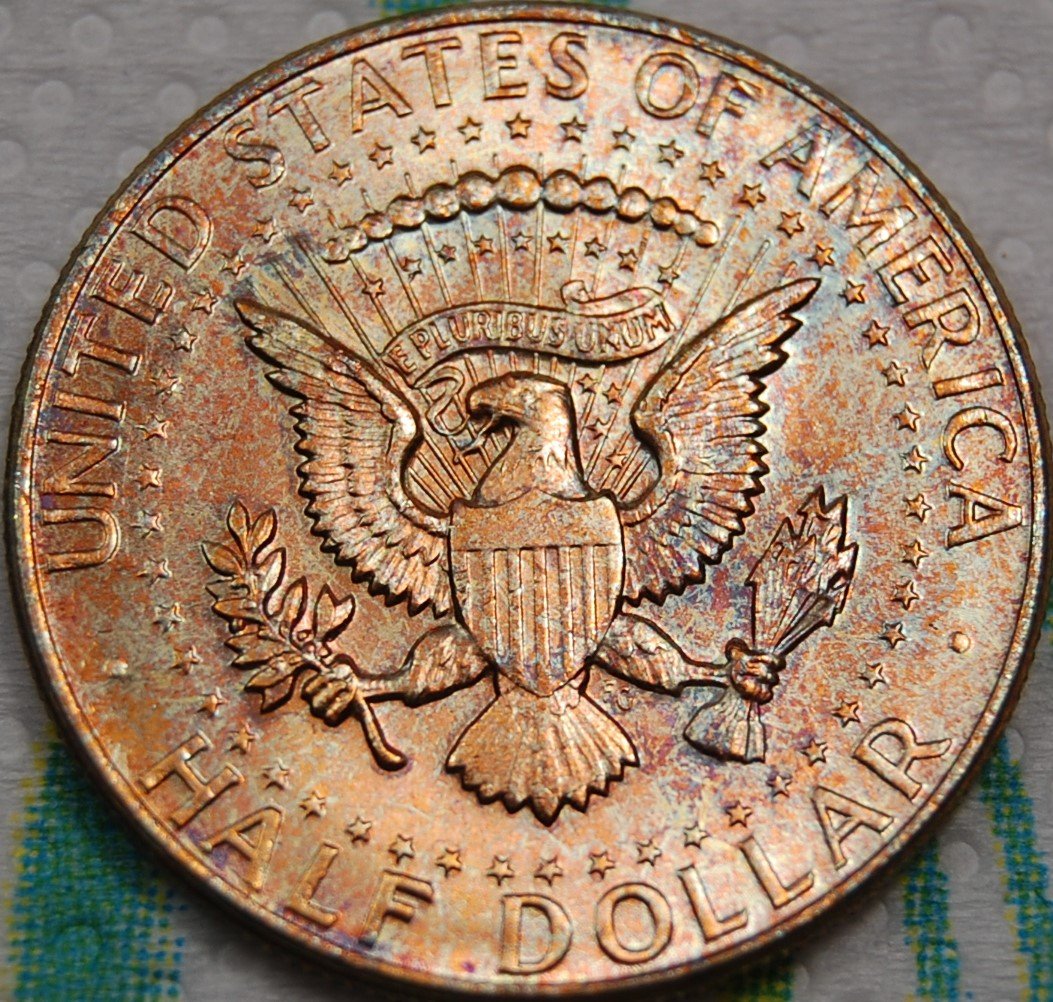One characteristic often seen on artificially toned coins is...
 Insider2
Posts: 14,452 ✭✭✭✭✭
Insider2
Posts: 14,452 ✭✭✭✭✭
Help me out here! I can only think of one, unusual patterns of color. What are some others?
![]()
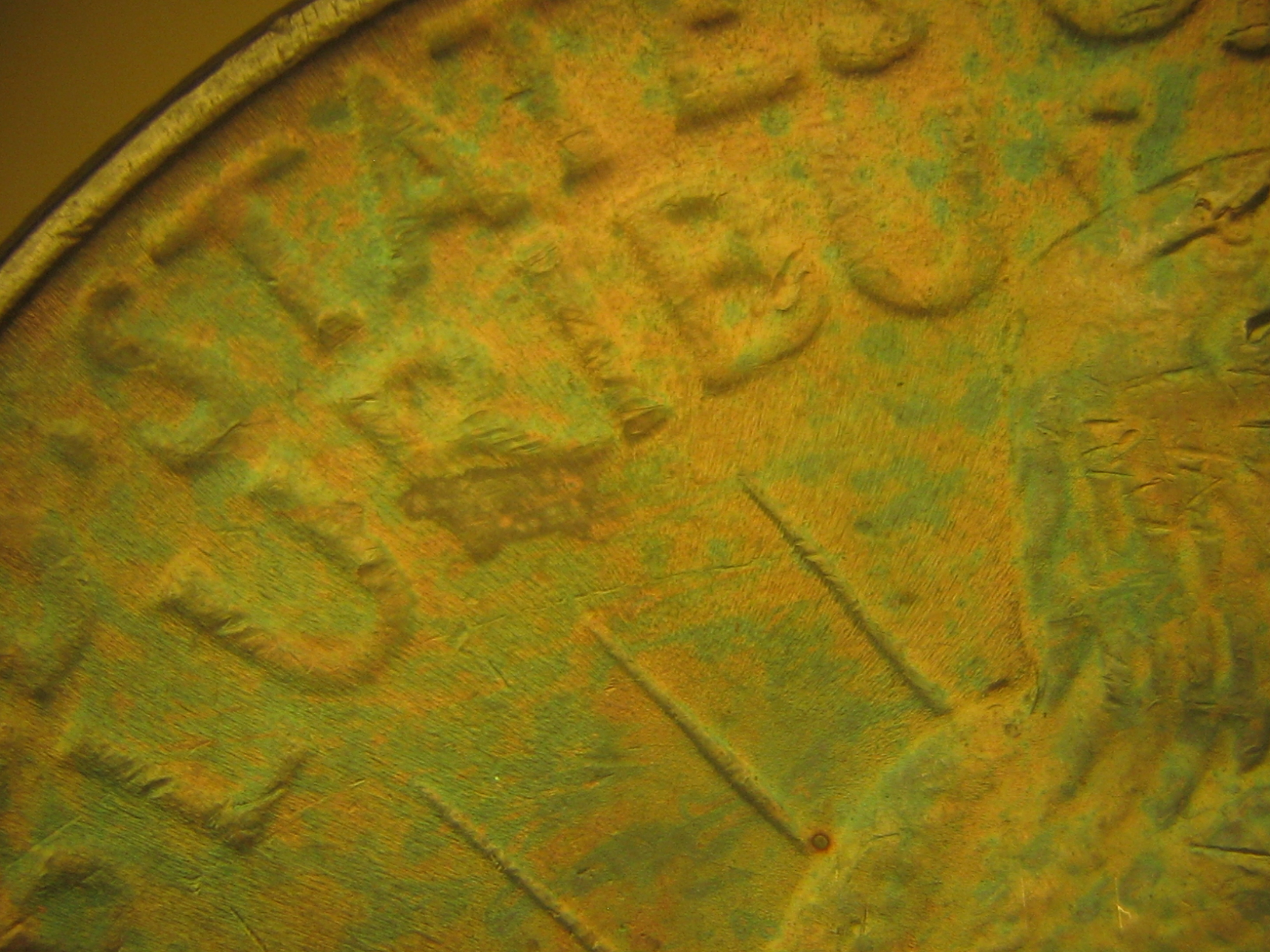
0
Comments
A single intense color (usually blue) on part of an otherwise white coin.
Lots of colorful toning on a cleaned surface.
Keeper of the VAM Catalog • Professional Coin Imaging • Prime Number Set • World Coins in Early America • British Trade Dollars • Variety Attribution
Regarding unusual patterns of color, the following is a half dollar I found in a bank roll. The pattern is unusual, and the colors are also more vivid than what I would assume occurs naturally (another characteristic I might associate with AT coins). That said, this coin was in the wild and I wouldn't expect a coin doctor to create an attractive AT coin and then just release it into commerce.
The "liver of sulfur" look. Intense colors with a toning pattern that makes no sense.
If it looks like it's painted on, rather than a reactive process, it probably was.
bob
No pull-away toning on AT, and toning in patterns and places not seen in NT.
Couldn’t some AT be added to a coin with pull away toning? I go with my gut on spotting problems on coins
It has served me well.
"They" say that this is being done.
Regarding the 1971 half dollar, the photos look like painted color but I don’t believe that's the case. This is what the coin looks like when tilted in the light. When not tilted in the light the coin has a fairly natural look. I suspect the coin must have come in contact with some substance to obtain this look, but I think it was probably accidental rather than intentional based on the circumstances of how I acquired it. Would be interested if anybody has theories for how this unusual toning could have arisen.
This is 'Pull-Away" toning:
Fresh dipped silver with deep amber, neon pink, electric blue.
Very easy.
Liberty: Parent of Science & Industry
Easy? I've NEVER SEEN fresh dipped silver with those colors and I've dipped a few coins in my life - including buckets & buckets full of BU silver for the "Shop at Home Show." It is a crying shame how many "rainbows" of all denominations ($ to dimes) that were ripped from their paper rolls and dumped in the buckets.
I'm going to hell for what I was told to do.
Artificially high price tag.
Worry is the interest you pay on a debt you may not owe.
"Paper money eventually returns to its intrinsic value---zero."----Voltaire
"Everything you say should be true, but not everything true should be said."----Voltaire
Any color on a Silver Eagle is AT. Silver doesn't tone that fast on it's own. And yet they get straight graded and real tone coins come back Questionable Toning!
Has anybody here noticed that sterling silver will tarnish much faster than 90% silver coinage? I did an experiment recently where I set out a cleaned silver Washington quarter next to a freshly polished silver platter. The silver platter tarnished after a few months but the quarter remained bright as ever. I found this interesting.
The little brown dots (there's one on OP's Peace dollar picture) is a pretty clear give away. Also, natural toning is often created due to air movement over the surface. Accordingly, authentic toning has large "patches" of color often lighter on the edges and more intense in the center. AT is often splotchy and confusing.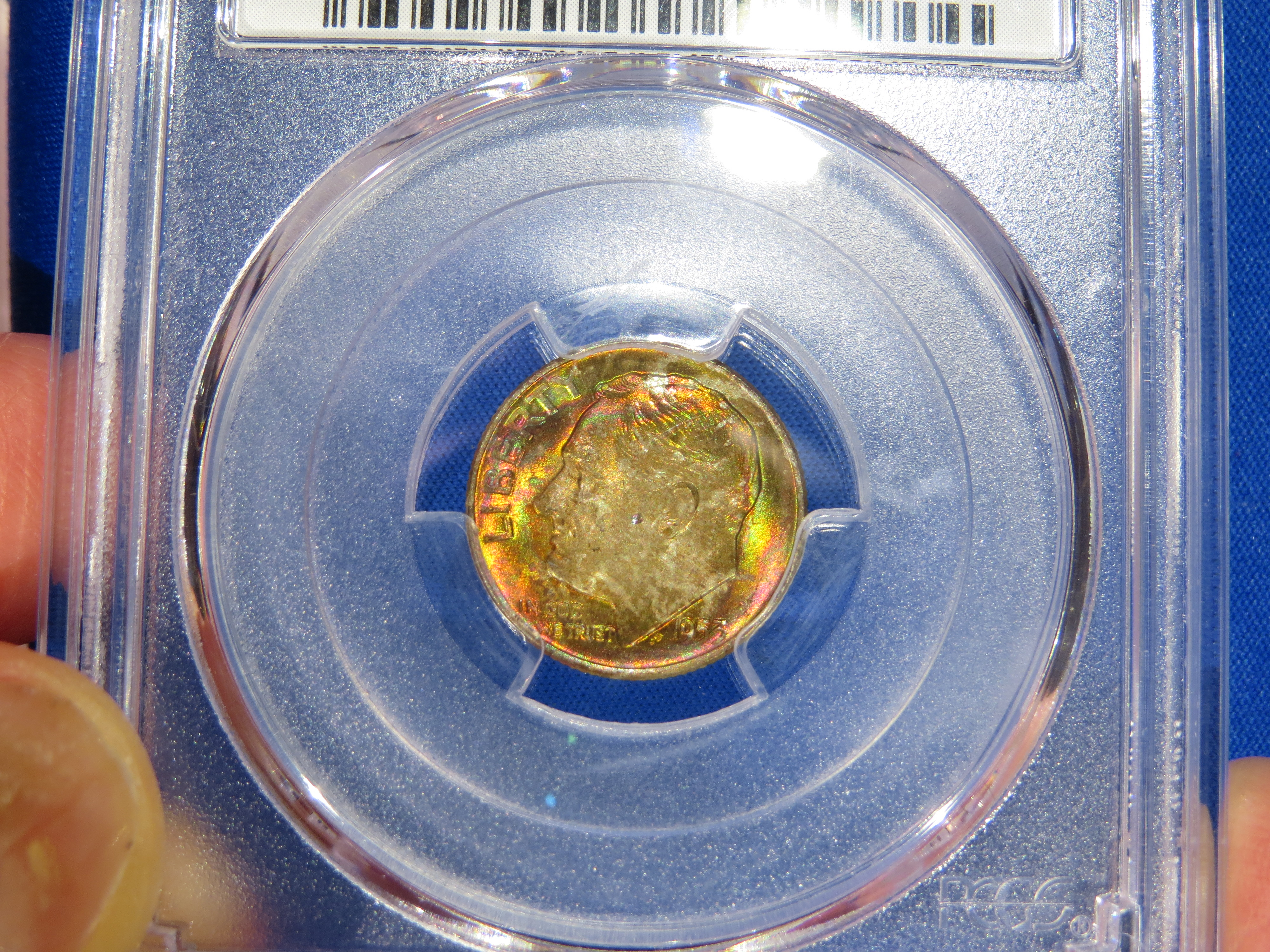
NT is embedded. At is on the surface.
@DollarAfterDollar said: "Also, natural toning is often created due to air movement over the surface. Accordingly, authentic toning has large "patches" of color often lighter on the edges and more intense in the center. AT is often splotchy and confusing."
That goes against a lot of coins I've seen that are darker around the edges. Obviously, it depends where the coin toned, album vs other. Is the dime you posted NT?
Hell might be too good for you unless it's sitting in front of a TV watching the "Shop at Home Show" into eternity.
😂😂😂
"Inspiration exists, but it has to find you working" Pablo Picasso
Taco bell sauce, remnants of hardboiled egg yolks
The whole worlds off its rocker, buy Gold™.
BOOMIN!™
Wooooha! Did someone just say it's officially "TACO™" Tuesday????
I've tuned in a few times - jewelry. I have to lock my wallet down and disconnect the phone as the pitches are great.
Whats the toning look like?
I would tend to agree....but. I have a Silver Eagle, early 90's?, that has a deep, deep, very dark purple toning line on the obverse rim and reeding. When I bought it I know did not have the toning. I have showed it to people who all agree it's AT. It has been stored in a mint tube for all these years. All the other coins in the tube are bright silver. Explanations welcome.
Clown.
Liberty: Parent of Science & Industry
I posted this discussion to see either examples of AT or written descriptions of the characteristics found on AT coins.
This "clown" is not amused. So far, I've been disappointed including your two attempts to help.
I have a serious question "Ringmaster." You made a statement. Now please educate us. Apparently, you have seen freshly dipped silver turn pretty colors. How? How much time? The ONLY color I've encountered is BROWN when the coin was not neutralized. Thanks in advance.
Why? What else would you do with your experiments?
I did all kinds of cleaning and toning experiments back in the day. All of those coins were released back into rolls
All comments reflect the opinion of the author, even when irrefutably accurate.
Can't explain, but I too have had rolls of ASE's where 1 coin in the middle of the roll tones and the others remain bright white. Older rolls.
I mean it’s completely possible that somebody released their experiment back into the wild, but I just wouldn’t expect it here. The coin has interesting (and IMO attractive) toning that a number of people would pay more than face value for, regardless of whether they think it’s AT or NT. The example I posted has the look of something made in the lab but I suppose it could have reached that appearance “naturally” via accidental exposure to some type of chemicals? No telling.
One thing I question is the date of the coin. Morgan Dollars with a colorful look most times are on the common dates mostly in MS 62- 64.
Floating colors.
Kind of heavy subject for me but it looks like a dab dab job
It looks "Cloroxed" to me.
I have seen many coins that looks very similar to this one, usually marked "monster", "killer", "Godzilla", etc.
Either the sellers are obtuse or crooked, or, possibly, both.
Obtuse. I like that. I wonder if any of them are nicknamed "Cookie"?
Pete
See above, that 71-D looks classic taco bell.
The whole worlds off its rocker, buy Gold™.
BOOMIN!™
Wooooha! Did someone just say it's officially "TACO™" Tuesday????
Years ago, I did extensive experimentation on tarnish....I actually found a method that was quite good...and today's coin doctors truly deserve the title - at least the good one's. The really good AT coins cannot be determined with anything other than opinions....done right, AT is 'accelerated' tarnish....since all tarnish is real....it is just the method by which it was incurred.....years ago, on this forum, it was determined that AT was determined by 'intent'...in other words, was it purposely exposed to an environment causing the tarnish... then it would be called AT (i.e. Taco Bell napkins etc.). Tarnish is environmental damage... some become attractive, some are not. Cheers, RickO
Over several decades I've personally opened over eighty Mint sealed Monster Boxes of SE (I know - that's not a lot).
Not one toned coin was encountered. Obviously, when the boxes are broken up, anything can happen PCI and put-together rolls of rejects.
Well...it's eighty more than I have opened.
Consider yourself VERY LUCKY! I feel very sorry for the young graders at the TPGS who eyeball these and other "moderns."
Rainbow colors....as others have noted before, what really is AT? I know what was meant by the thread, but some think ANY rainbow colors on coins is a function of AT, just varied techniques (blow torch vs. years in a holder near plastic), etc.
I disagree. Assuming a coin doctor cooks a thousand coins, and only 80 sell on eBay, he probably does release the unsellable ones back into commerce.
Another indication of AT: Chemical flow with a strong border.
Nope. Had more than enough of your inane contradictions and deliberate obtuseness in all of the net grading attempts to communicate with you. Not going to even try on the subject of toning. Don't have the time nor patience these days.
Liberty: Parent of Science & Industry
or as my aunt would say a dippy do job
AT (in my opinion) and in an ms66 TPG holder....................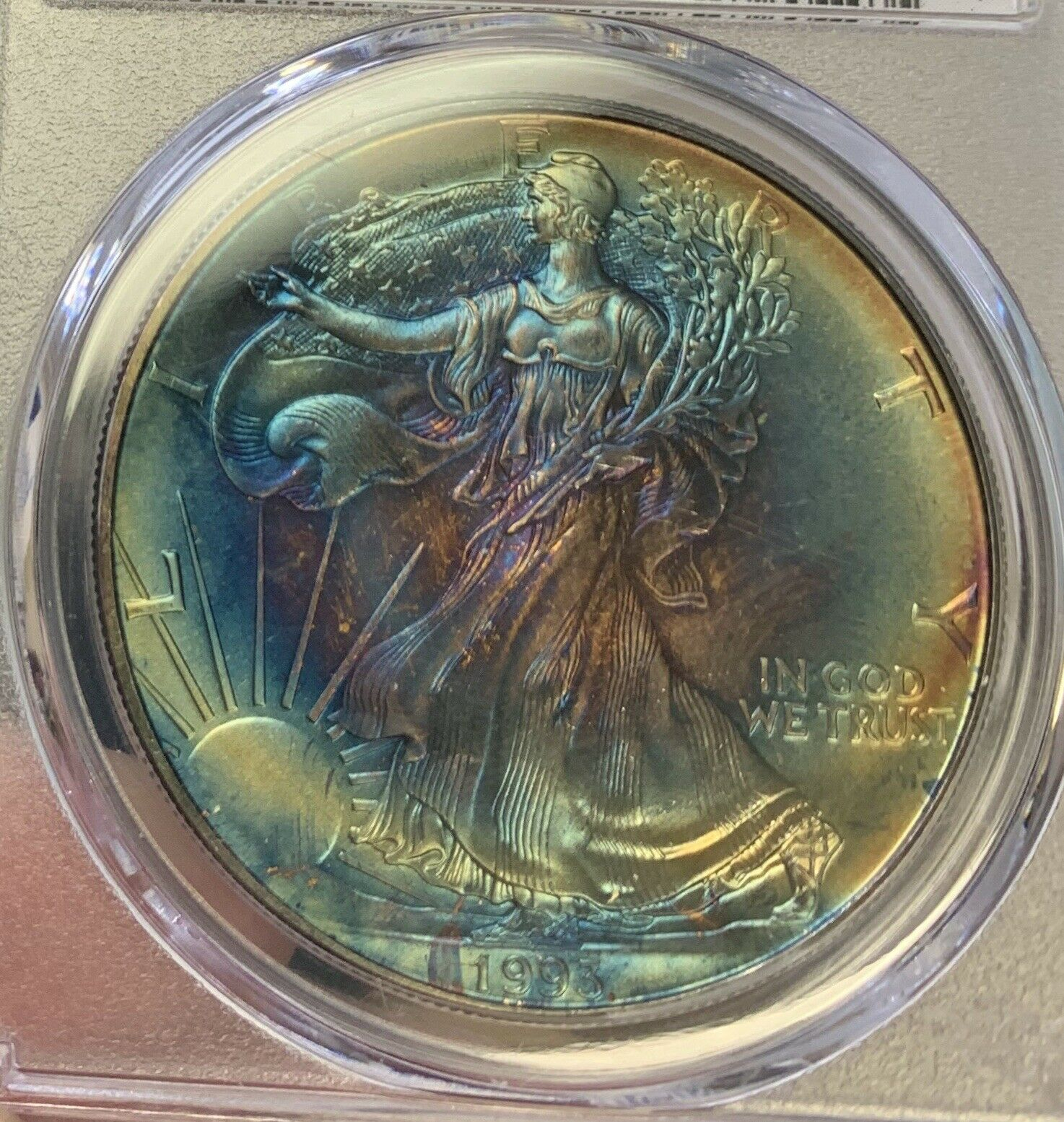
"“Those who sacrifice liberty for security/safety deserve neither.“(Benjamin Franklin)
"I only golf on days that end in 'Y'" (DE59)
This post is the usual reaction I run across from folks who cannot "defend" a silly statement or answer a simple question after posting "amazing to me, first-hand knowledge!" Not surprised, instead, attack me - ** a clown** - because of my posts about how silly net grading is - which I explain with reasons for this opinion.
That's really naturally artificial toning. I've seen a lot of ASE's like that when they were bought in snap together plastic cases with a cardboard insert. The cardboard appears to be high in sulfur. This is really a form of album toning which you can consider either natural or artificial, I suppose.
All comments reflect the opinion of the author, even when irrefutably accurate.
Interesting.....
I guess now we have to determine if this example would be market acceptable.
I vote NO.
"“Those who sacrifice liberty for security/safety deserve neither.“(Benjamin Franklin)
"I only golf on days that end in 'Y'" (DE59)
You are overruled. PCGS voted Yes! They control more of the market than we do.
This is what came to my mind first: A lack of pull-away toning. Not all naturally toned coins show this characteristic, but the coin artists have yet to replicate it.
For those who don't know what "pull-away toning means," here is a Morgan dollar in our current holdings that shows it at the lower-left obverse denticles, at the date, and several of the lower-right obverse stars.
Kind regards,
George
To be fair, I've seen such coins voted Yes and I've seen coins with the same origin voted No. This is the area where there is probably the most inconsistency in the TPGS's.
All comments reflect the opinion of the author, even when irrefutably accurate.
What characteristics are on this coin to tell wheather it is AT or NT?
